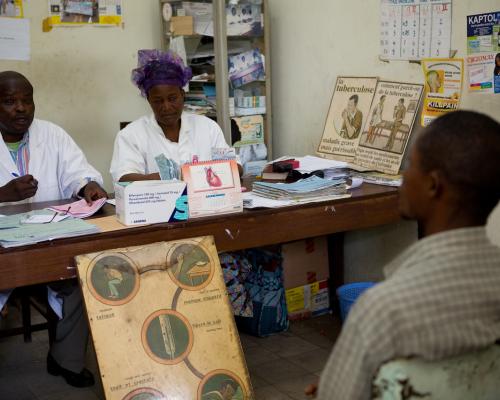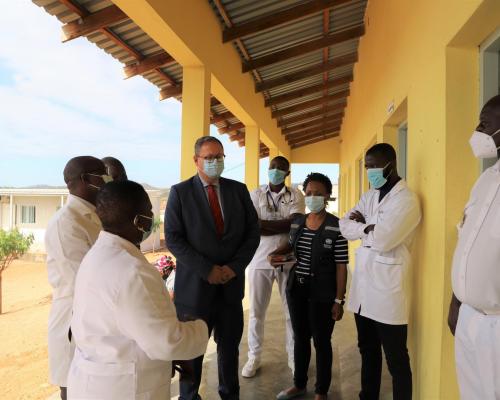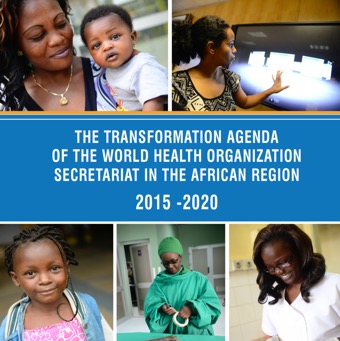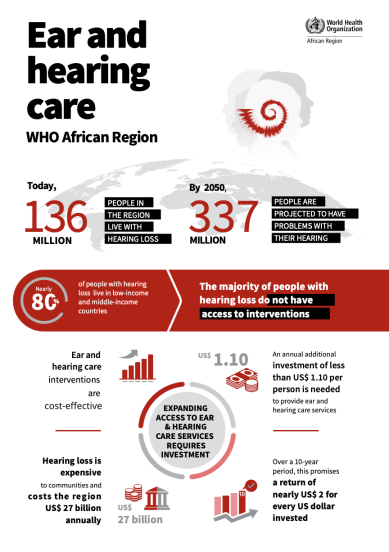Hearing loss is on the rise globally. Up to 80% of people with hearing loss live in low- and middle-income countries. In 2023, estimates showed that there are 40 million people Africa with hearing loss. This projected to rise to 54 million people in 2030 and 97 million people with hearing loss in 2050 [1, 2].
Hearing loss may occur at any point across the life course of an individual. Some causes of hearing loss tend to affect individuals at a certain stage in their life course beginning from the prenatal period, perinatal period, childhood and adolescence or even in adulthood and older age. However, some factors causing hearing loss may occur at any stage across the life course [1]. Up to 60% of causes of hearing loss and deafness are preventable using simple public health interventions at the community level [3].
The key challenges to curbing the rise in the prevalence of hearing loss is lack of health system capacity for provision of integrated ear and hearing care (EHC) across the life course, and societal misperceptions and stigmatizing mindsets that influence care seeking causing those affected to either not seek treatment at all, to seek traditional treatment which usually causes more harm or to not utilise recommended treatment options such as hearing aids due to stigma [1, 4].
The consequences of unaddressed hearing loss are far reaching. At an individual level, unaddressed hearing loss negatively impacts communication and speech development, academic achievements and prospects of gainful employment, causes social isolation and stigma as well as overall quality of life of living with disability [2, 4]. Failing to address hearing loss costs African economies USD27.1 billion mainly due to loss of productivity and social isolation attributed to unaddressed hearing loss.
Hearing loss is defined as hearing at thresholds greater than 20dB in the better ear while deafness is hearing at thresholds above 95dB on both ears. Hearing loss greater than 35 decibels (dB) in the better hearing ear is referred to as disabling hearing loss. Hearing loss; measured in decibels, is classified as mild, moderate, moderately severe, severe or profound. This could affect one ear or both ears. Hearing thresholds of 20dB or better in one ear and greater than 35dB in the other ear is termed as unilateral hearing loss. Hearing loss results in difficulties engaging in conversational speech or even hearing loud sounds [1].
People with hearing loss ranging from mild to severe are referred to as Hard of hearing. They can communicate using spoken language but may benefit from hearing aids, cochlear implants, and other assistive devices as well as captioning. Deaf people have very minimal or no hearing at all. They rely on sign language, assistive listening technology and captioning to communicate.
Grading of hearing loss and functional consequence of each grade (From World Report on Hearing [1] )
An individual can develop hearing impairment at any time across the lifespan. However, there are periods in the life course when people are more susceptible to developing hearing loss from specific causes.
- Prenatal period
- Genetic factors including hereditary & non-hereditary hearing loss
- Intrauterine infections such as Rubella, Cytomegalovirus (CMV)
- Herpes simplex virus type 1 and 2
- Human immunodeficiency virus
- Syphilis
- Perinatal period
- Birth asphyxia (a lack of oxygen at the time of birth
- Hyperbilirubinemia (severe jaundice in the neonatal period)
- Low-birth weight
- Other perinatal morbidities and their management, ototoxicity
- Noise in NICU
- Childhood and adolescence
- Chronic ear infections
- Infections common in childhood eg Measles, Meningitis, Mumps
- Adulthood and older age
- Chronic diseases
- Smoking
- Otosclerosis
- Age-related sensorineural degeneration
- Sudden sensorineural hearing loss
- Factors across the life course
- Impacted ear wax
- Trauma to the ear or head
- Loud noise/loud sounds
- Ototoxic medicines
- Work related ototoxic chemicals
- Nutritional deficiencies
- Viral infections and other ear conditions
- Delayed onset or progressive genetic hearing loss
- Poor performance in school
- It negatively impacts listening, communication and interpersonal relationships
- Causes delays in language and speech development if it occurs prelingually
- People with hearing loss are unable to pursue education optimally
- Hearing loss decreases opportunities of employability and financial wellbeing
- Individuals with hearing loss are subjected to social isolation, loneliness and stigma
- Hearing loss in the elderly results in cognition decline and increases the risk of dementia
- Hearing loss negatively impacts the mental health of the affected individual
- The top five causes of hearing loss are Chronic otitis media (COM), impacted wax, presbycusis, ototoxicity, and meningitis respectively. However, the exact epidemiology varies among countries in the region.
- There is a clear need to strengthen leadership for ear and hearing care (EHC). Of the 43 countries that responded, only 11 (26%) had a national strategic plan, a subnational strategy/ plan or a programme for ear and hearing care (EHC).
- Only 47% (20/43) of countries reported having a national coordinator for EHC, but very few have government led hearing screening programmes, either for newborns, schoolchildren or older persons.
- While a huge proportion of hearing loss can be addressed with hearing aids, majority of the countries where hearing aids are available, they are self-funded. Medical products and technologies remain out of reach for most people in the region due to their unavailability and high costs.
- Only 47% (20/43) of countries offer EHC services at the primary care level. This increases to 86% (36/43) at the secondary level. This is evidence for lack of integration of EHC in the health care system across all countries in the region.
- Over a third of EHC services are provided in the private sector, which underscore the contribution of private sector in health care provision.
- Ear and hearing care workforce presents a significant challenge in the region. Up to 88% of countries have less than 5 ENT surgeons, 93% of countries have less than 5 audiologists and 86% of countries have less than 5 speech and language therapists for a million inhabitants. While there is a huge shortage of audiologists, only 7% of countries have more than 5 hearing aid technicians for a million inhabitants.
- To bridge the gap of EHC workforce, 88% (33/43) of countries have health workforce trained on-the-job to perform some EHC tasks such as diagnosis of ear diseases, ear irrigation, foreign body removal or hearing assessment. Of these, only 24 countries (56%) have training facilities for human resource for EHC regardless of the level of training.
- While a huge proportion of hearing loss can be addressed with hearing aids, these are mostly unavailable and when available, are often self-funded and costly. Other required medical products and technologies, such as cochlear implants, captioning and other assistive listening devices are unavailable in majority of countries.
- Up to 35% of countries do not have a government budget dedicated to EHC. In the public sector, only 14% of countries offer services free of charge while costs are completely borne by patients in 32% of countries.
- Only 65% of countries report EHC related indicators in the Health Information System (HIS).
Challenges, opportunities, and priorities
- The main challenges facing EHC service delivery include:
- Low awareness among policymakers and the public and misconceptions about hearing loss and ear diseases.
- Lack of high-level leadership and governance for strengthening EHC delivery across the continuum of care.
- Fragmented and vertical service delivery with no integration of EHC services into primary health care or complementary programs.
- Inadequate trained and qualified human resources for EHC across all categories, with available resources concentrated in urban areas.
- Lack of equipment for diagnosis and management of EHC conditions.
- Out-of-pocket expenditure for care and medical products and technologies even when services would result in catastrophic expenditure, thus prohibiting care-seeking.
- Failure to include EHC standardized indicators in national health information systems.
Opportunities to strengthen EHC
- World Health Assembly resolution (WHA70.13) on the prevention of deafness and hearing loss, endorsed and supported by all countries in the African region.
- The current focus on health system strengthening, primary health care, and integrated people-centered care to achieve universal health coverage.
- Established programs for noncommunicable diseases, maternal and child health, early childhood development, among others, in which EHC can be integrated.
- Focus on disability policies/acts, whose implementation could help mitigate the impact of hearing loss.
- Advocacy opportunities provided by the global focus on World Hearing Day on 3 March.
Priorities to address existing challenges and bridge the identified gaps
- Improve awareness about good ear and hearing care (EHC) practices, and safe listening as a means for hearing loss prevention and its early identification.
- Develop, adopt and implement national strategies that aims to strengthen efforts for prevention of hearing loss and integrate EHC provision across the life course.
- Integrate people-centered ear and hearing care within the primary health care framework along the life course as part of ongoing efforts for universal health coverage.
- Establish ear and hearing care training programmes/courses for different cadre responding to the needs of Member States.
- Equip public health facilities at different levels with suitable diagnostic, curative, and rehabilitative equipment.
- Adopt innovative approaches through use of digital technologies, mhealth, telehealth and task sharing to integrate people-centered ear and hearing care along the life course as part of universal health coverage.
- Make medical technologies and consumables for EHC affordable and accessible to all.
- Integrate indicators for ear and hearing care within national health information systems, monitor and report on these regularly.
- Strengthen groups and associations of hard of hearing or deaf people, as a step towards addressing the stigma that is commonly associated with hearing loss.
Over 60% of causes of hearing loss in Africa are preventable through simple and cost-effective evidence based public health measures. Ear and Hearing Care should be integrated into the primary health care system and primary healthcare workers be empowered to make diagnosis and treat ear and hearing disorders as part of continuum of care for other conditions, so no one is left behind. In regard, the acronym HEARING summarizes the different interventions to realize comprehensive, and Integrated People Centered Ear and Hearing Care (IP-EHC). The interventions include: Hearing screening and intervention, Ear disease prevention and management, Access to technologies, Rehabilitation services, Improved communication, Noise reduction, Greater community engagement
To achieve this, the WHO employs different strategies ranging from advocacy to development of resources to support member countries to strengthen ear and hearing care to prevent hearing loss and deafness. Some of the activities and resources include:
- Raising awareness among policy makers, key stakeholders and the general public on the burden of hearing loss, it’s impact on the affected person, the society and the economy through strategies such as the World Hearing Day. Link to:
- The World Report on Hearing
- World report on hearing- executive summary
- Advocating for integrated people centered ear and hearing care (IPC-EHC) strategies in the health care system beginning with empowering the community level to perform early identification and management ear diseases. Link to IPC-EHC tools:
- Integrated People Centred Ear and Hearing Care: Policy brief
- Basic Ear and Hearing Care Resource
- Primary Ear and Hearing Care Training manual
- Supporting ministries of health to include EHC indicators in the Health Management System and encourage population surveys to gather data on hearing loss and ear disease so as to provide an evidence-based case for the need to elevate EHC in health planning and financing. Link resources:
- Situation analysis tool
- Planning & monitoring of national strategies
- Indicators for monitoring provision of services
- Supporting capacity building of human resources for ear and hearing care through increasing training opportunities for different cadre and empowering the PHC system to provide EHC services. Link to resources:
- Basic ear and hearing
- Primary ear and hearing care training manual
- Strengthening EHC service delivery including screening programs for all at risk individuals across the lifecourse, management of disease and ensuring access to affordable and quality hearing devices and other rehabilitation and communication strategies. Link to resources:
- Survey handbook
- Hearing screening: considerations for implementation
- HearWHO, hearWHOpro
- Raising awareness on avoidable causes of hearing loss and draft adopt and implement legislation to protect the public with regards to noise, recreational and occupational noise induced hearing loss as well as ototoxicity. Links to resources:
- WHO Global standard for safe listening venues and events
- Be healthy be mobile, Handbook on mSafeListening
- World Health Organization. World report on hearing. 2021 20/05/2021]; Available from: https://www.who.int/publications/i/item/9789240020481
- World Health Organization. Deafness and hearing loss. 2021 [cited 2022 11/08/2022]; Available from: https://www.who.int/news-room/fact-sheets/detail/deafness-and-hearing-loss.
- World Health Organization, Report of the international workshop on Primary Ear and Hearing Care. 1998: Cape Town.
- Davis, A.C. and H.J. Hoffman, Hearing loss: rising prevalence and impact. Bulletin of the World Health Organization, 2019. 97(10): p. 646.




